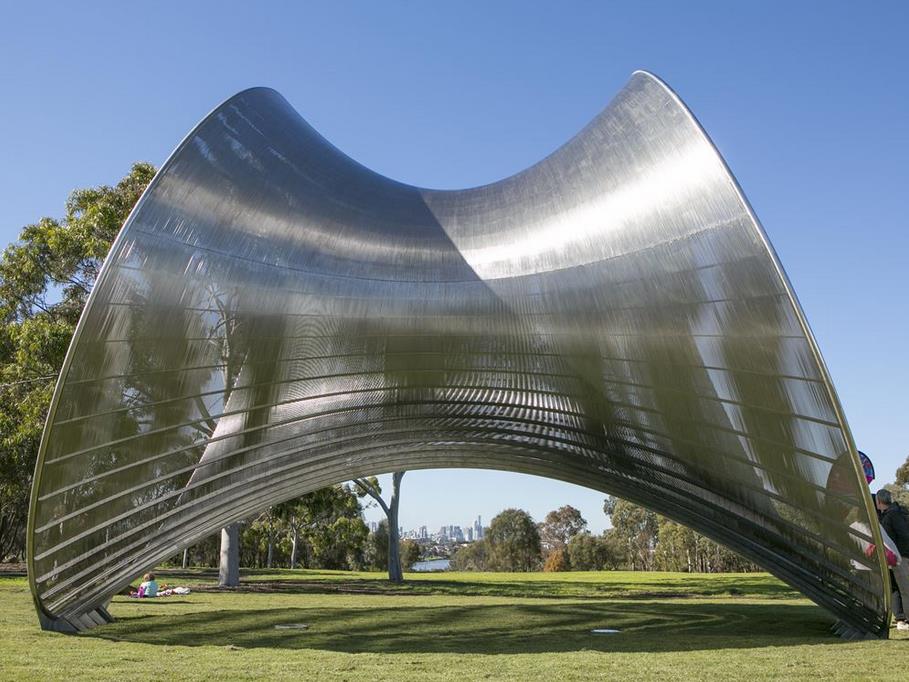Maribyrnong City Council commissioned the public artwork, Pipedreams – a 12 metre wide and 8 metre high stainless steel sculpture, created and installed by renowned Australian artist, Matthew Harding.
On Saturday, 26 August this year, vandals attacked three historic statues in Sydney’s Hyde Park, tagging them with the words ‘Change the date’ and ‘No pride in genocide’. All four sides of the Captain Cook statue’s base were targeted; statues of Governor Macquarie and Queen Victoria were also tagged. Prime Minister Malcolm Turnbull reacted by calling the graffitiing a ‘cowardly criminal act’.
Dr Michael Hill, Head of Art History & Theory, National Art School, Sydney, opened a discussion on the role of public art at the Sydney Sculpture Conference by recalling the incident.
‘It challenged the idea that colonial monuments can effectively represent today’s community, but instead – given they are heavy, made of bronze, granite, clearly immovable and obviously sanctioned by the state – they embody a version of history that is contested,’ he said.

The vandalised Captain Cook statue. Picture: David Swift
Hill continued: ‘What is public sculpture meant to do, who does it represent, does it embody public values and does it do more than that – what is public sculpture’s role?’
Read: How public art is adapting to our changing world
Hill said that he was depressed by the public debate that followed that defacing of the Hyde Park sculptures because it didn’t explore the questions and complexities behind sculpture, but rather just became ‘a football that you kick around in a public debate. Why should sculpture be the thing that pays the price?’ he added.
Public art for whom?
Victorian Artist Matthew Harding said an artist has a different type of responsibility when creating a public artwork compared to the personal responsibility one places on oneself in the studio.
He added that while briefs can be a torment, they help to define the framework one works within. ‘When you enter the permanent and solid, especially in the public domain, those restrictions – and there a lot of hurdles to be dealt with – are challenging.
‘The thing about art in public spaces is that we try to ascribe meaning to it – you probably spend more time thinking about what it means and trying to articulate that in the brief – but in the end it becomes its own animal and the public will make of it what they will,’ he continued.
‘We are lucky if someone understands the full depth of what you are trying to express,’ said Harding.
Professor Lv Pinchang, Head of Sculpture, Central Academy for Fine Art, Beijing agreed. ‘In our city life we need something that you feel that you can’t understand,’ he said.
Pinchang believes that because everything is so ordered and regulated in societies – parks, roads, public transport – something in the public space needs to belong to the individual.
‘Sometimes sculptors get a lot of money to create a project that not a lot of people will understand. People would ask, “Why would they still exist?” The answer is because we need them,’ he continued.
‘In my opinion, sculptors can be a licenced person to do nothing. You can do whatever you feel like producing, and that work, that is yours. I think that is the value why public sculpture has existed so long,’ explained Pinchang.
The Central Academy for Fine Art will partner in hosting next year’s Sculpture Conference.
Read: How conversation can solve contemporary issues
Pinchang cited the example of Richard Serra’s 37 meter long steel plate sculpture, Tilted Arc, which ran across New York’s Federation Square. It was removed in 1989 after much public criticism. The intention of the sculpture was to block people’s tracks in everyday life and slow them down.
‘The United States is famous for its openness and tolerance, but in terms of this artwork I felt that it lacked tolerance. This type of thing is easy to understand if it happened in China but it happened in the United Sates.

Richard Serra’s Tilted Arc.
‘In my opinion there is no way a piece of public art can be everybody’s favourite. Therefore, I think that sculpture in a public space should be about a place where you can express yourself. I conclude that public art can be about aesthetics, and sometimes about the function of healing and sometimes just a view piece – but I would be reluctant to exaggerate the function of public art,’ Pinchang said.
‘My wish is for more tolerance and acceptance for our sculptors and artists,’ he concluded.
This discussion was held as part of the Sydney Sculpture Conference, at the Sydney Opera House on 2 November 2017. The annual conference is an initiative of Sculpture by the Sea.




